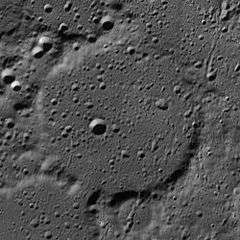Poncelet (crater)
Poncelet is the remains of a lunar impact crater that is located near the northern limb of the Moon. It lies to the east-northeast of the crater Pascal and northwest of Anaximenes. Like the latter formation, Poncelet is a worn, eroded formation with an interior that has been flooded, either with lava or possibly ejecta. The outer rim is a low, circular ridge with a narrow break to the south and a wider breach to the northeast. The interior floor is pock-marked with many tiny craterlets, the most notable of which is Poncelet H, located just to the southeast of the midpoint.
 LRO mosaic | |
| Coordinates | 75.8°N 54.1°W |
|---|---|
| Diameter | 69 km |
| Depth | Unknown |
| Colongitude | 57° at sunrise |
| Eponym | Jean V. Poncelet |
Satellite craters
By convention these features are identified on lunar maps by placing the letter on the side of the crater midpoint that is closest to Poncelet.
| Poncelet | Latitude | Longitude | Diameter |
|---|---|---|---|
| A | 79.5° N | 74.7° W | 31 km |
| B | 78.6° N | 62.3° W | 32 km |
| C | 77.4° N | 73.7° W | 67 km |
| D | 77.7° N | 70.0° W | 23 km |
| H | 75.7° N | 55.2° W | 7 km |
| P | 80.6° N | 61.1° W | 15 km |
| Q | 79.9° N | 59.9° W | 14 km |
| R | 79.3° N | 57.3° W | 10 km |
| S | 78.7° N | 56.2° W | 10 km |
gollark: I accidentally made my search engine start parsing a bunch of *images*; oops!
gollark: Now to figure out how much data I can gather about search results to ~~sell to Google~~ optimize my services!
gollark: I tick those boxes there to allow it to index those sites.
gollark: I've made a bit of a frontend for my search engine thing. Though it can't actually do search yet, only crawl/index/whatever pages.
gollark: Basically, if I want to run a search it just goes `SELECT * FROM page_tokens WHERE token = 'one token in search query'` or something like that, and it now has a list of pages with the right token, and SQLite can execute this query relatively fast.
References
- Andersson, L. E.; Whitaker, E. A. (1982). NASA Catalogue of Lunar Nomenclature. NASA RP-1097.CS1 maint: ref=harv (link)
- Blue, Jennifer (July 25, 2007). "Gazetteer of Planetary Nomenclature". USGS. Retrieved 2007-08-05.CS1 maint: ref=harv (link)
- Bussey, B.; Spudis, P. (2004). The Clementine Atlas of the Moon. New York: Cambridge University Press. ISBN 978-0-521-81528-4.CS1 maint: ref=harv (link)
- Cocks, Elijah E.; Cocks, Josiah C. (1995). Who's Who on the Moon: A Biographical Dictionary of Lunar Nomenclature. Tudor Publishers. ISBN 978-0-936389-27-1.CS1 maint: ref=harv (link)
- McDowell, Jonathan (July 15, 2007). "Lunar Nomenclature". Jonathan's Space Report. Retrieved 2007-10-24.CS1 maint: ref=harv (link)
- Menzel, D. H.; Minnaert, M.; Levin, B.; Dollfus, A.; Bell, B. (1971). "Report on Lunar Nomenclature by the Working Group of Commission 17 of the IAU". Space Science Reviews. 12 (2): 136–186. Bibcode:1971SSRv...12..136M. doi:10.1007/BF00171763.CS1 maint: ref=harv (link)
- Moore, Patrick (2001). On the Moon. Sterling Publishing Co. ISBN 978-0-304-35469-6.CS1 maint: ref=harv (link)
- Price, Fred W. (1988). The Moon Observer's Handbook. Cambridge University Press. ISBN 978-0-521-33500-3.CS1 maint: ref=harv (link)
- Rükl, Antonín (1990). Atlas of the Moon. Kalmbach Books. ISBN 978-0-913135-17-4.CS1 maint: ref=harv (link)
- Webb, Rev. T. W. (1962). Celestial Objects for Common Telescopes (6th revised ed.). Dover. ISBN 978-0-486-20917-3.CS1 maint: ref=harv (link)
- Whitaker, Ewen A. (1999). Mapping and Naming the Moon. Cambridge University Press. ISBN 978-0-521-62248-6.CS1 maint: ref=harv (link)
- Wlasuk, Peter T. (2000). Observing the Moon. Springer. ISBN 978-1-85233-193-1.CS1 maint: ref=harv (link)
This article is issued from Wikipedia. The text is licensed under Creative Commons - Attribution - Sharealike. Additional terms may apply for the media files.